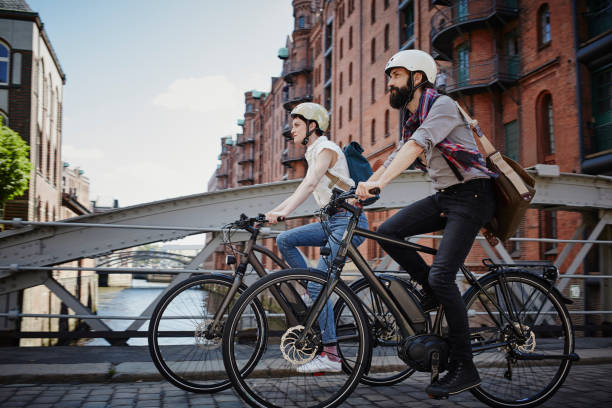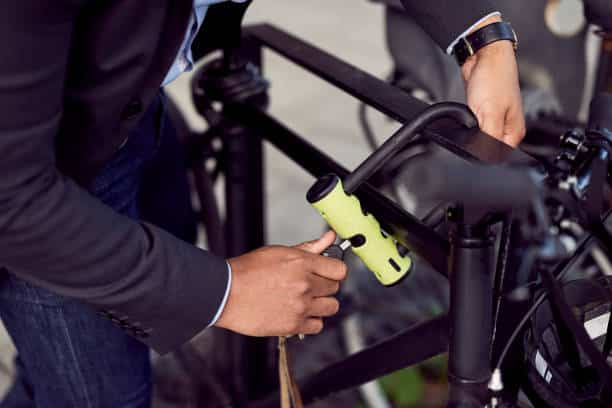Introduction to E-Bike Safety Gear
As the popularity of electric bicycles (e-bikes) continues to soar, it’s crucial that riders prioritize their safety and invest in the right gear. E-bikes offer a convenient and eco-friendly mode of transportation, but they also come with unique safety considerations.
From high speeds to increased weight, e-bikes require specialized safety equipment to ensure riders can navigate the roads and trails with confidence.
In this comprehensive article, we’ll explore the essential safety gear for e-bike riders, covering everything from helmets and gloves to protective clothing and eye protection.
We’ll also delve into the importance of locks, visibility, and maintenance in keeping e-bike riders safe. By the end of this guide, you’ll have a thorough understanding of the must-have safety gear for e-bike enthusiasts, empowering you to ride with peace of mind.
Helmet: The Most Important Piece of Safety Gear

When it comes to e-bike safety, the helmet is undoubtedly the most crucial piece of equipment. E-bikes can reach high speeds, and in the event of a collision or fall, a well-designed helmet can mean the difference between a minor incident and a life-threatening injury.
Helmet Types and Features
There are several types of helmets available for e-bike riders, each with its own set of features and benefits. The most common types include:
- Road Bike Helmets: These lightweight, aerodynamic helmets are designed for high-speed riding and offer excellent protection for the head.
- Mountain Bike Helmets: Featuring a more rugged design and often including a visor, mountain bike helmets are well-suited for off-road e-bike adventures.
- Commuter Helmets: These helmets strike a balance between style and safety, making them a popular choice for urban e-bike riders.
- Full-Face Helmets: Offering the highest level of protection, full-face helmets cover the entire head and face, making them a wise choice for extreme riding conditions.
When selecting a helmet, look for features such as impact-absorbing foam, adjustable fit, and ventilation to ensure maximum comfort and safety.
Helmet Fit and Adjustment
Proper helmet fit is crucial for ensuring optimal protection. A well-fitted helmet should sit level on your head, with the front edge just above your eyebrows. The straps should form a V-shape under your ears, and the chin strap should be snug but not too tight.
To adjust the fit, use the dial or pads at the back of the helmet to tighten or loosen the fit as needed. Ensure that the helmet does not move excessively when you shake your head.
Helmet Maintenance and Replacement
Helmets are not designed to last forever. Over time, the materials can degrade, compromising their ability to protect you in the event of a crash.
As a general rule, replace your helmet every 3-5 years, or immediately after any significant impact.
It’s also important to inspect your helmet regularly for signs of wear and tear, such as cracks, dents, or loose straps. If you notice any damage, it’s best to replace the helmet, even if it’s within the recommended lifespan.
While a standard helmet is essential for e-bike safety, some riders may also consider investing in a bike helmet for added protection. Bike helmets are designed specifically for use on bicycles, including e-bikes, and offer a higher level of impact protection compared to traditional helmets.
Features of Bike Helmets
Bike helmets typically feature a more robust construction, with a hard outer shell and a thick, impact-absorbing liner. They may also include additional safety features, such as:
- MIPS (Multi-Directional Impact Protection System): This technology helps to reduce the rotational forces that can occur during a crash, providing an extra layer of protection for the head.
- Integrated Lights: Some bike helmets come equipped with built-in LED lights, enhancing the rider’s visibility and improving safety, especially during low-light conditions.
- Ventilation: Bike helmets often feature extensive ventilation systems to keep the rider cool and comfortable, even during strenuous rides.
When selecting a bike helmet, look for one that meets safety standards, such as CPSC (Consumer Product Safety Commission) or SNELL certification, and fits your head comfortably.
Bike Helmet Fit and Adjustment
Proper fit is just as important for bike helmets as it is for standard helmets. The helmet should sit level on your head, with the front edge just above your eyebrows. Adjust the straps to create a secure, snug fit, and ensure that the helmet does not move excessively when you shake your head.
Bike Helmet Maintenance and Replacement
As with standard helmets, bike helmets should be replaced every 3-5 years or immediately after any significant impact. Inspect your helmet regularly for signs of wear and tear, and replace it if you notice any cracks, dents, or other damage.
Gloves: Protecting Your Hands

While a helmet is the most crucial piece of safety gear, gloves are also an essential component of an e-bike rider’s protective equipment. Gloves can help prevent injuries to your hands and fingers in the event of a fall or collision.
Types of Gloves
There are several types of gloves designed specifically for e-bike riding, each with its own set of features and benefits:
- Fingerless Gloves: These gloves provide protection for the palms and backs of the hands while leaving the fingers exposed, allowing for better dexterity and control.
- Full-Finger Gloves: Offering more comprehensive coverage, full-finger gloves protect the entire hand, including the fingers, and are well-suited for colder weather or off-road riding.
- Padded Gloves: Featuring extra padding on the palms and knuckles, these gloves can help absorb the impact of a fall and reduce the risk of hand injuries.
- Touchscreen-Compatible Gloves: These gloves allow you to operate your smartphone or e-bike display without having to remove them, making them a convenient choice for urban riders.
When selecting gloves, consider the type of riding you’ll be doing, the weather conditions, and your personal preferences for dexterity and protection.
Glove Fit and Comfort
Proper glove fit is essential for both comfort and safety. Gloves should be snug but not too tight, allowing for a full range of motion in your fingers and hands. Look for gloves with adjustable closures, such as Velcro or elastic, to ensure a secure and customized fit.
Additionally, consider the breathability and moisture-wicking properties of the gloves, as this can help keep your hands cool and dry during longer rides.
Glove Maintenance and Replacement
Like helmets, gloves can wear out over time. Inspect your gloves regularly for signs of wear, such as fraying, holes, or worn-out padding. Replace your gloves if you notice any significant damage or if they no longer provide the level of protection and comfort you need.
Elbow Pads: Protecting Your Arms

While helmets and gloves are essential for protecting your head and hands, elbow pads can also play a crucial role in e-bike safety. Elbow pads can help prevent abrasions, bruises, and more serious injuries to your arms in the event of a fall or collision.
Types of Elbow Pads
There are several types of elbow pads designed for e-bike riding, including:
- Soft Elbow Pads: These pads feature a flexible, padded design that offers basic protection without restricting movement.
- Hard-Shell Elbow Pads: Featuring a rigid outer shell, hard-shell elbow pads provide more comprehensive protection, making them a good choice for off-road or high-speed riding.
- Hinged Elbow Pads: These pads have a hinged design that allows for a full range of motion while still providing impact protection.
When selecting elbow pads, consider the type of riding you’ll be doing, the level of protection you require, and the overall comfort and fit of the pads.
Elbow Pad Fit and Comfort
Proper fit is crucial for ensuring that your elbow pads provide the necessary protection without compromising your mobility or comfort. Look for pads that are snug but not too tight, and ensure that they stay in place during your ride.
Many elbow pads feature adjustable straps or closures to help you achieve a customized fit. Additionally, consider the breathability and moisture-wicking properties of the pads, as this can help keep you cool and comfortable during longer rides.
Elbow Pad Maintenance and Replacement
Like other safety gear, elbow pads can wear out over time. Inspect your pads regularly for signs of wear, such as fraying, cracking, or loss of padding. Replace your elbow pads if you notice any significant damage or if they no longer provide the level of protection you need.
Locks: Securing Your E-Bike

In addition to personal safety gear, it’s also important to consider the security of your e-bike. Locks are an essential accessory for protecting your investment and deterring theft.
Types of Locks
There are several types of locks designed for e-bikes, each with its own strengths and weaknesses:
- U-Locks: These heavy-duty locks are known for their strength and resistance to cutting and prying.
- Chain Locks: Offering more flexibility in terms of locking locations, chain locks can be wrapped around larger objects or multiple bikes.
- Cable Locks: While not as secure as U-locks or chain locks, cable locks are lightweight and convenient, making them a good choice for quick stops.
- Disc Brake Locks: These specialized locks attach directly to your e-bike’s disc brake, preventing the wheel from turning and deterring theft.
When selecting a lock, consider the level of security you require, the weight and portability of the lock, and the specific features that best suit your needs.
Lock Placement and Usage
Proper lock placement is crucial for maximizing the security of your e-bike. When locking your bike, always secure it to a sturdy, immovable object, such as a bike rack or street sign. Avoid locking your e-bike to objects that can be easily cut or broken, such as thin trees or fences.
Additionally, be sure to lock your e-bike in a well-lit, high-traffic area whenever possible, as this can help deter potential thieves.
Lock Maintenance and Replacement
Like any other piece of equipment, locks can wear out over time. Inspect your locks regularly for signs of wear, such as rust, cracks, or loose components. Replace your locks if you notice any significant damage or if they no longer provide the level of security you need.
Protective Clothing: Staying Safe in Style

While safety gear like helmets and gloves are essential, protective clothing can also play a crucial role in e-bike safety. Investing in the right apparel can help shield you from the elements, reduce the risk of injuries, and enhance your overall riding experience.
Types of Protective Clothing
Some of the most important protective clothing items for e-bike riders include:
- Jackets: Look for jackets with impact-absorbing padding, water-resistant or waterproof materials, and high-visibility features.
- Pants: Durable, abrasion-resistant pants can help protect your legs in the event of a fall or collision.
- Shoes: Sturdy, slip-resistant shoes with good ankle support can improve your control and stability on the e-bike.
- Base Layers: Moisture-wicking base layers can help regulate your body temperature and keep you comfortable during longer rides.
When selecting protective clothing, consider the weather conditions, the type of riding you’ll be doing, and your personal style preferences.
Fit and Comfort
Proper fit is essential for ensuring that your protective clothing provides the necessary coverage and protection without compromising your mobility or comfort. Look for garments that are snug but not too tight, and allow for a full range of motion.
Additionally, consider the breathability and moisture-wicking properties of the clothing, as this can help keep you cool and dry during your rides.
Maintenance and Replacement
Like other safety gear, protective clothing can wear out over time. Inspect your garments regularly for signs of wear, such as fraying, holes, or loss of padding.
Replace any items that no longer provide the level of protection or comfort you need.
Eye Protection: Shielding Your Vision

While often overlooked, eye protection is another crucial component of e-bike safety gear. Riding an e-bike can expose your eyes to a variety of hazards, from debris and insects to glare and UV radiation.
Types of Eye Protection
There are several types of eye protection designed for e-bike riders, including:
- Sunglasses: Polarized or tinted sunglasses can help reduce glare and protect your eyes from harmful UV rays.
- Goggles: Wraparound goggles offer more comprehensive coverage, shielding your eyes from wind, dust, and other airborne particles.
- Prescription Eyewear: For riders who require corrective lenses, prescription eyewear can be customized to provide both vision correction and protection.
When selecting eye protection, consider the level of coverage you need, the lighting conditions you’ll be riding in, and any specific features, such as anti-fog or scratch-resistant coatings.
Fit and Comfort
Proper fit is essential for ensuring that your eye protection stays in place and provides the necessary coverage. Look for eyewear that fits snugly but comfortably, with no gaps around the edges.
Additionally, consider the weight and ventilation of the eyewear, as this can impact your comfort and visibility during longer rides.
Maintenance and Replacement
Like other safety gear, eye protection can wear out over time. Inspect your eyewear regularly for signs of wear, such as scratches, cracks, or loose components. Replace any items that no longer provide the level of protection or clarity you need.
Visibility: Staying Seen on the Road

In addition to personal protective equipment, visibility is a crucial aspect of e-bike safety. Ensuring that you and your e-bike are easily seen by other road users can help prevent collisions and improve your overall safety.
Lighting and Reflective Gear
Some of the most effective visibility-enhancing accessories for e-bike riders include:
- Front and Rear Lights: Bright, high-quality lights can improve your visibility, especially during low-light conditions or at night.
- Reflective Tape and Stickers: Applying reflective materials to your e-bike and clothing can make you more visible to drivers, especially in the dark.
- Reflective Vests and Jackets: Wearing high-visibility, reflective outerwear can significantly improve your conspicuity on the road.
When selecting visibility-enhancing gear, look for products that are durable, weatherproof, and easy to install or attach to your e-bike and clothing.
Riding Techniques for Visibility
In addition to using specialized visibility gear, there are also several riding techniques that can help improve your safety:
- Positioning: Ride in a position that maximizes your visibility to other road users, such as the center of the lane or in a dedicated bike lane.
- Signaling: Use hand signals to indicate your turns and lane changes, making your intentions clear to drivers around you.
- Defensive Riding: Anticipate the actions of other road users and be prepared to react quickly to potential hazards.
By combining the use of visibility-enhancing gear with safe riding practices, you can significantly reduce the risk of being involved in a collision.
Maintenance and Repair: Keeping Your E-Bike in Top Shape

Proper maintenance and repair are essential for ensuring the ongoing safety and reliability of your e-bike. Regular inspections and timely repairs can help prevent mechanical failures and reduce the risk of accidents.
Routine Maintenance
Some of the key maintenance tasks for e-bike riders include:
- Battery Maintenance: Regularly check your e-bike’s battery for signs of wear or damage, and follow the manufacturer’s recommendations for charging and storage.
- Tire Inspection and Inflation: Ensure that your tires are properly inflated and in good condition, with no signs of wear or damage.
- Brake Inspection and Adjustment: Regularly check your brakes for proper function and adjust them as needed to maintain optimal performance.
- Chain Lubrication: Keep your e-bike’s chain well-lubricated to prevent wear and ensure smooth, efficient pedaling.
By staying on top of these maintenance tasks, you can help ensure the long-term safety and reliability of your e-bike.
Repair and Troubleshooting
In the event of a mechanical issue or breakdown, it’s important to have the necessary tools and knowledge to perform basic repairs and troubleshooting. Some essential items to include in your e-bike repair kit include:
- Tire Repair Kit: Includes tire levers, patches, and a portable pump to fix flat tires on the go.
- Multi-Tool: A versatile multi-tool with various wrenches, screwdrivers, and hex keys can help you make adjustments and minor repairs.
- Spare Parts Keep a few spare parts on hand, such as inner tubes, brake pads, and derailleur hangers, to quickly address common issues.
- Diagnostic Tools Tools like a voltmeter or battery tester can help you identify and troubleshoot electrical problems with your e-bike’s motor and battery.
It’s also a good idea to familiarize yourself with basic repair and maintenance techniques, such as changing a flat tire, adjusting brakes, and lubricating the chain. Many e-bike manufacturers and cycling organizations offer maintenance and repair workshops or online tutorials to help riders develop these essential skills.
Riding Techniques: Mastering E-Bike Control

In addition to investing in the right safety gear and maintaining your e-bike, developing proper riding techniques is crucial for ensuring a safe and enjoyable riding experience.
Balance and Stability
E-bikes are heavier and more powerful than traditional bicycles, which can impact their handling and stability. Mastering techniques like weight distribution, cornering, and braking can help you maintain control and navigate challenging terrain or situations.
Speed Management
E-bikes can reach high speeds, which requires careful speed control and reaction time. Practice accelerating and decelerating smoothly, and learn how to anticipate and respond to potential hazards.
Terrain Adaptation
Whether you’re riding on paved roads, gravel paths, or off-road trails, it’s important to adapt your riding style to the terrain and conditions. Techniques like shifting your weight, adjusting your suspension, and selecting the appropriate pedal assist mode can help you navigate different surfaces safely.
Emergency Maneuvers
In the event of an unexpected situation, such as a sudden obstacle or loss of traction, it’s crucial to be prepared to perform emergency maneuvers. Practice techniques like emergency braking, swerving, and obstacle avoidance to develop the reflexes and muscle memory needed to react quickly and effectively.
By mastering these riding techniques, you can enhance your control, confidence, and overall safety on your e-bike.
Rider Education and Training

Alongside investing in the right safety gear and developing proper riding techniques, rider education and training can also play a crucial role in e-bike safety.
E-Bike Safety Courses
Many cycling organizations, local governments, and e-bike manufacturers offer specialized safety courses for e-bike riders. These courses typically cover topics such as:
- Helmet fitting and adjustment
- Proper use of safety gear
- Riding techniques and skills
- Traffic laws and regulations
- Maintenance and troubleshooting
Participating in these courses can help you develop the knowledge and skills needed to ride your e-bike safely and confidently.
Online Resources and Tutorials
In addition to in-person training, there are also numerous online resources and tutorials available to help e-bike riders learn about safety and best practices. These can include:
- Instructional videos
- Safety guides and articles
- Interactive quizzes and assessments
- Forums and discussion boards
By taking advantage of these educational resources, you can continue to expand your knowledge and stay up-to-date on the latest e-bike safety recommendations.
Conclusion: Prioritizing E-Bike Safety
As the popularity of electric bicycles continues to grow, it’s essential that riders prioritize their safety and invest in the right gear and practices.
From helmets and gloves to protective clothing and visibility-enhancing accessories, there are numerous safety components that e-bike riders should consider.
Beyond personal protective equipment, proper maintenance, repair, and riding techniques are also crucial for ensuring a safe and enjoyable riding experience. And by taking advantage of rider education and training opportunities, e-bike enthusiasts can further develop the knowledge and skills needed to navigate the roads and trails with confidence.
By embracing a comprehensive approach to e-bike safety, riders can not only protect themselves but also contribute to a safer and more sustainable transportation ecosystem.
So, whether you’re a seasoned e-bike commuter or a newcomer to the world of electric bicycles, make safety your top priority and ride with the peace of mind that comes from being prepared.





